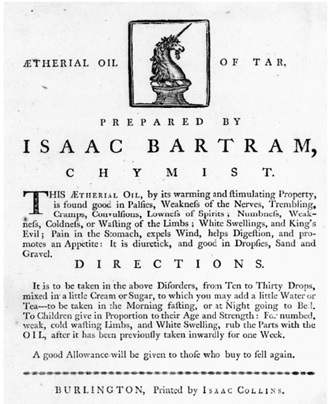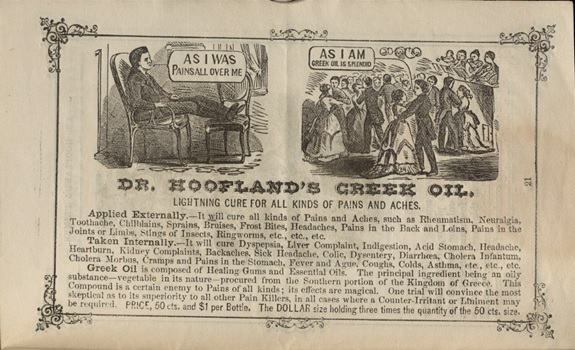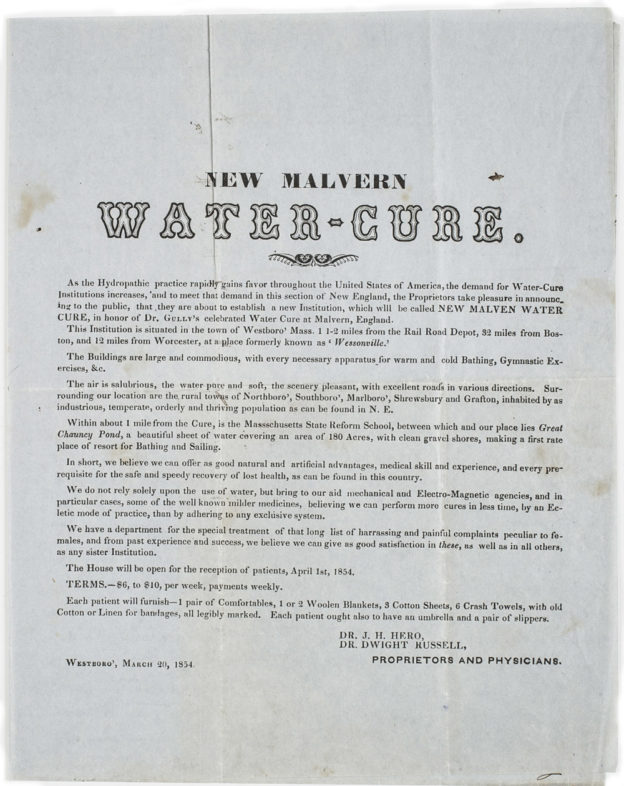In popular culture within the United States, many have heard of the “snake oil salesman” – a stock character in Western movies depicted as a supposed traveling doctor who peddles “medical” oils, elixirs, tonics, pills, bitters, liniments, tinctures, salts, powders, or syrups to unsuspecting crowds of passers-by. An accomplice in the crowd (a “shill”) attests to the effectiveness of the product being sold to increase sales. By the time customers realize they’ve been swindled, the “doctor” is already long gone. Although such individual salesmen were cultural tropes, the medicines they peddled at their American Old West-themed medicine shows – more widely known as “patent medicines” – were a popular part of American life and culture in the 18th and 19th century.
What are patent medicines? Patent medicines – also known as “nostrum”, from the Latin nostrum remedium, meaning “our remedy” – were commercial products sold in the 18th and 19th century United States as purported over-the-counter medicines that made bold and sometimes far reaching claims about their curative properties. Many of these medicines were trademarked, but not patented in the way we think of patents today. The term “patent medicine” came about in the late 17th century marketing of medical elixirs in Europe, when those who found favor with royalty were issued “letters patent” – legal instruments in the form of a published written order issued by a monarch or other head of state – authorizing the use of the royal endorsement in advertising of products such as elixirs. Chemical patenting as we know it today did not occur within the United States until about 1925.
What did these medicines contain? Usually patent medicines were made of relatively inexpensive ingredients sold at high prices. It is important to know that because many patent medicines did not explicitly list their ingredients, those who sold it could make lofty claims about what their medicines contained. For example, particular herbs were frequently talked of being medical wonders in the advertising of patent medicines, but their actual effects would come from other unnamed substances (such as procaine extracts [used as local anesthetics] or grain alcohol). Patent medicines could contain a combination of ingredients such as oils, water, sugar, herbs, minerals, alcohols, chemical compounds, etc., and sometimes they contained potentially harmful (but surprisingly still legal) substances. Why would anyone put such substances into their patent medicines? Patent medicine manufacturers needed substances in their product that had noticeable effects on the body, for there is only so far a placebo effect will work on consumers. The easiest way to do so was by adding laxatives, diuretics, stimulants, and/or depressants to their products. For example, “infant soother” medicines frequently contained opium. Opiates in general – which were legal at the time and sometimes effective in relieving pain, coughs, and diarrhea – were added to medicines despite their known addictive properties (many such medicines were advertised as causing “none of the harmful effects of opium,” though some actually did contain opium). The effect that these substances had on the body made consumers of patent medicines feel as though the medicine was working in some way – whether by creating an effect on the body that would distract them from their symptoms or would help to temporarily relieve or mask their symptoms.
What did these medicines claim to cure? While some patent medicines made specific claims about their curative properties, many could be labeled as “cure-alls” – they claimed to cure a wide variety of illnesses. For example, Isaac Bartram’s Ætherial Oil of Tar (advertised via an 1773 broadside, see figure 1 below), claimed “by its warming and stimulating property, is found good in [curing] palsies, weakness of nerves, trembling, cramps, convulsions, lowness of spirits; numbness, weakness, coldness, or wasting of the limbs; white swellings, and King’s Evil; pain in the stomach, expels wind, helps digestion, and promotes an appetite.”
 Figure 1: Ætherial Oil of Tar, prepared by Isaac Bartram, Chymist, (Burlington [N.J.]: Isaac Collins, [1773?]).
Figure 1: Ætherial Oil of Tar, prepared by Isaac Bartram, Chymist, (Burlington [N.J.]: Isaac Collins, [1773?]).
Dr. Hoofland’s Greek Oil, advertised within Dr. Hoofland’s Primer (see figure 2 below), when “applied externally,” it claimed to “cure all kinds of pains and aches, such as rheumatism, neuralgia, toothache, chilblains, sprains, bruises, frost bites, headaches, pains in the back and loins, pains in the joints or limbs, stings of insects, ringworms, etc., etc., etc.” and when “taken internally” it claimed to “cure dyspepsia, liver complaint, indigestion, acid stomach, headache, heartburn, kidney complaints, backaches, sick headache, colic, dysentery, diarrhoea, cholera infantum, cholera morbus, cramps and pains in the stomach, fever and ague, coughs, colds, asthma, etc., etc., etc.”
 Figure 2: Dr. Hoofland’s Primer, ([Philadelphia]: Charles M. Evans, [between 1869 and 1872?]), 21.
Figure 2: Dr. Hoofland’s Primer, ([Philadelphia]: Charles M. Evans, [between 1869 and 1872?]), 21.
How were patent medicines sold within the United States? Patent medicines were mainly sold via advertisements within almanacs and newspapers, but were also advertised in a variety of other ways. One 1872 source summed up American’s experiences with patent medicine advertising:
We take up our morning journal: its columns are crowded by patent medicine advertisements. We turn in disgust from their glaring statements, and attempt to read a news item. We get half through, and find we are sold into reading a puff for the same trashy article. We take a horse-car for up or down town, and opposite, in bold and variegated letters, the persistent remedy (?) stares you continually in the face. We enter the post office: the lobbies are employed for the exposition, perhaps sale, of the patent medicines. We open our box: “O, we’ve a large mail to-day!” we exclaim; when lo! Half of the envelopes contain patent medicine advertisements, which have been run through the post office into every man’s box in the department. And so it goes all day.[1]
Sounds eerily similar to our modern day advertising woes, doesn’t it? Although I believe the book from which the above passage originates from was intended to be a collection of satirical anecdotes of the time, it does paint a realistic image of how widely patent medicines were advertised within the United States in the late 19th century; such patent medicine advertisements were peppered throughout Americans’ daily lives (see figure 3 below).
 Figure 3: “If you travel on the railroad you will recognize this as a familiar scene. Wherever you go, all over this country, you will find attractive signs relating to Hood’s Sarsaparilla.” C.I. Hood & Co., Hood’s Sarsaparilla Painting Book, ([Lowell, Mass.]: Art Dept. of C.I. Hood Co., 1894.), 23.
Figure 3: “If you travel on the railroad you will recognize this as a familiar scene. Wherever you go, all over this country, you will find attractive signs relating to Hood’s Sarsaparilla.” C.I. Hood & Co., Hood’s Sarsaparilla Painting Book, ([Lowell, Mass.]: Art Dept. of C.I. Hood Co., 1894.), 23.
As patent medicine advertising became more prevalent, some sellers of patent medicines realized that their products had to have a gimmick to set them apart from the competition (testimonies and letter patents aside). One such gimmick was the theme of exoticism and mystery – claiming that their product was made with “exotic” ingredients or recipes from far-away lands. Take the above mentioned Dr. Hoofland’s Greek Oil (figure 2) – its “principal ingredient” was “an oily substance – vegetable in its nature – procured from the southern portion of the Kingdom of Greece. This compound is a certain enemy to pains of all kinds; its effects are magical.” Another example of this is Tish-Wang, “the Great Chinese Remedy,” which claimed to cure a variety of venereal diseases. In an 1863 advertisement (see figure 4 below), the seller claims to have purchased this medicine from reputable medical staff in London:
An English surgeon, while with the Army in India, obtained the secret from a Chinese physician, and the Remedy has been used for several years with great success in the hospitals of Europe. The undersigned purchased the recipe from a member of the medical profession of this city, recently returned from England, where he obtained the secret and witnessed its curative powers on the patients of one of the most celebrated Lock Hospitals in London.
 Figure 4: Samuel C. (Samuel Curtis) Upham, Tish-wang, the Great Chinese Remedy for Gonorrhoea, Gleet, Strictures, Syphilis, Gravel, Seminal Weakness, &c. ([Philadelphia : s.n., 1863]).
Figure 4: Samuel C. (Samuel Curtis) Upham, Tish-wang, the Great Chinese Remedy for Gonorrhoea, Gleet, Strictures, Syphilis, Gravel, Seminal Weakness, &c. ([Philadelphia : s.n., 1863]).
Why don’t we still have patent medicines today? The death of patent medicines came, in part, thanks to a 1905 article written by Samuel Hopkins Adams, an American author and muckraker journalist. This article, entitled “The Great American Fraud,” was an 11 part series for Collier’s magazine in which Adams exposed patent medicines’ fraudulent claims and revealed how some of these medicines were damaging people’s health. This article’s publication allegedly played a part in influencing the passage of the Pure Food and Drug Act of 1906, the first significant consumer protection law in the United States. This law required that active ingredients be placed on the label of a drug’s packaging – which meant the beginning of the end for patent medicines in the United States.
[1] Addison Darre Crabtre, The Funny Side of Physic: or, The Mysteries of Medicine. (Hartford : J.B. Burr & Hyde, 1872), 86.

